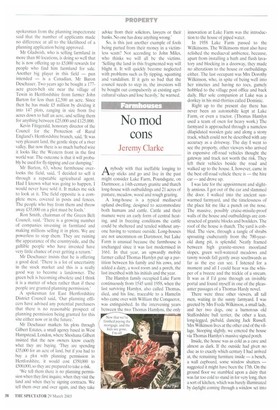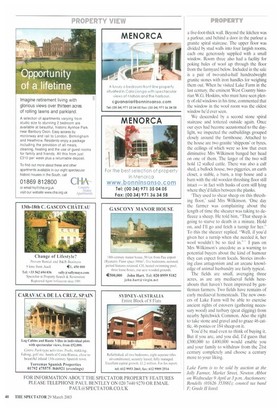No mod cons
Jeremy Clarke
Anybody with that ineffable longing to up sticks and go and live in the past might consider Lake Farm, Poundsgate, on Dartmoor, a 14th-century granite and thatch long-house with outbuildings and 21 acres of pasture, meadow, wood and rough grazing.
A long-house is a typical mediaeval upland dwelling, designed to accommodate both humans and cattle, Cattle and their manure were an early form of central heating, and in freezing conditions the cattle could be sheltered and tended without anyone having to venture outside. Long-houses are not uncommon on Dartmoor, but Lake Farm is unusual because the farmhouse is unchanged since it was last modernised in 1661. In that year, an upwardly mobile farmer called Thomas Hamlyn put up a partition between his family and his cows, and added a dairy, a wool room and a porch, the last inscribed with his initials and the year.
The Hamlyn family occupied Lake Farm continuously from 1545 until 1958, when the last surviving Hamlyn, also called Thomas, died, and his line, traceable to a Hamelin who came over with William the Conqueror, was extinguished. In the intervening years between the two Thomas Hamlyns, the only innovation at Lake Farm was the introduction to the house of piped water.
In 1958 Lake Farm passed to the Wiikinsons. The Wilkinsons must also have relished the mediaeval ambience, because, apart from installing a bath and flush lavatory and blocking in a doorway, they made no alterations to the house or outbuildings either. The last occupant was Mrs Dorothy Wilkinson, who, in spite of being well into her nineties and having no toes, gamely hobbled to the village post office and back daily. Her sole companion at Lake was a donkey in his mid-thirties called Dominic.
Right up to the present day there has never been an automobile kept at Lake Farm, or even a tractor. (Thomas Hamlyn used a team of oxen for heavy work.) The farmyard is approached through a nameless dilapidated wooden gate and along a stony track, which could not be described with any accuracy as a driveway. The day I went to see the property, other viewers who arrived in expensive off-road vehicles thought the gateway and track not worth the risk. They left their vehicles beside the road and walked up to the house. I, however, came in the best off-road vehicle there is — the hire car — and drove up.
I was late for the appointment and slightly anxious. I got out of the car and slammed the door. I walked into the ancient sunwarmed farmyard, and the timelessness of the place hit me like a punch on the nose. The massive, possibly cruise-missile-proof walls of the house and outbuildings are constructed of granite blocks and boulders. The roof of the house is thatch. The yard is cobbled. The view, through a tangle of shrubs sprouting exuberantly from the 700-yearold dung pit, is splendid. Neatly framed between high granite-strewn moorland slopes, green well-watered meadows and tawny woods fall gently away southwards as far as the eye can see. I listened for a moment and all I could hear was the whisper of a breeze and the trickle of a stream. It was as if I'd gone through an invisible portal and found myself in one of the pleasanter passages of a Thomas Hardy novel.
There were three other viewers, all tall men, waiting in the sunny farmyard. I was greeted by Mrs Freda Wilkinson, a small lady, and her two dogs, one a humorous old Staffordshire bull terrier, the other a lean, long-legged, piebald, dancing Jack Russell. Mrs Wilkinson lives at the other end of the village. Stooping slightly, we entered the house via Thomas Hamlyn's massive signed porch.
Inside, the house was as cold as a cave and almost as dark. If the outside had given no clue as to exactly which century I had arrived at, the remaining furniture inside — a bench, a wall cupboard, some window shutters — suggested it might have been the 17th. On the ground floor we stumbled upon a dairy that was far too cold to stand in for very long, then a sort of kitchen, which was barely illuminated by daylight coming through a window set into a five-foot-thick wall. Beyond the kitchen was a parlour, and behind a door in the parlour a granite spiral staircase. The upper floor was divided by stud walls into four largish rooms, each one generously supplied with a small window. Room three also had a facility for poking bales of wool up through the floor from the farmyard below. Included in the sale is a pair of two-and-a-half hundredweight granite stones with iron handles for weighing them out. When he visited Lake Farm in the last century, the eminent West Country historian W.G. Hoskins, who must have seen plenty of old windows in his time, commented that the window in the wool room was the oldest window he'd ever seen.
We descended by a second stone spiral staircase and tottered outside again. Once our eyes had become accustomed to the daylight, we inspected the outbuildings grouped closely around the farmhouse. Attached to the house are two granite `shippons' or byres, the ceilings of which were so low that even diminutive Mrs Wilkinson banged her head on one of them. The larger of the two will hold 12 stalled cattle. There was also a calf shed, a bullock house, two piggeries, an earth closet, a stable, a barn, a trap house and a barn with the old wooden threshing floor still intact — in fact with husks of corn still lying where they'd fallen between the planks.
'They used to shear sheep on this threshing floor,' said Mrs Wilkinson. 'One day the farmer was complaining about the length of time the shearer was taking to defleece a sheep. He told him, "That sheep is going to starve to death in a minute. Hold on, and I'll go and fetch a turnip for her." To this the shearer replied. "Well, if you'd given her a turnip when she needed it, her wool wouldn't be so tied in."' I pass on Mrs Wilkinson's anecdote as a warning to potential buyers about the kind of humour they can expect from locals. Stories involving class antagonism and an arcane knowledge of animal husbandry are fairly typical.
The fields are small, averaging three acres, as are any mediaeval fields hereabouts that haven't been improved by gentleman farmers. Two fields have remains of early mediaeval homesteads. The new owners of Lake Farm will be able to exercise ancient rights of estovers (gathering necessary wood) and turbary (peat digging) from nearby Spitchwick Common. Also the right to take stone and gravel and to graze 46 cattle, 46 ponies or 184 sheep on it.
You'd be mad even to think of buying it. But if you are, and you did, I'd guess that 000,000 to £400,000 would enable you and your family to withdraw from the 21st century completely and choose a century more to your liking.
Lake Farm is to be sold by auction at the Jolly Farmer, Market Street, Newton Abbot on Wednesday 9 April at 3 p.m. Auctioneers: Rendells (01626 353881); council tax band F; Grade II listed.









































































 Previous page
Previous page